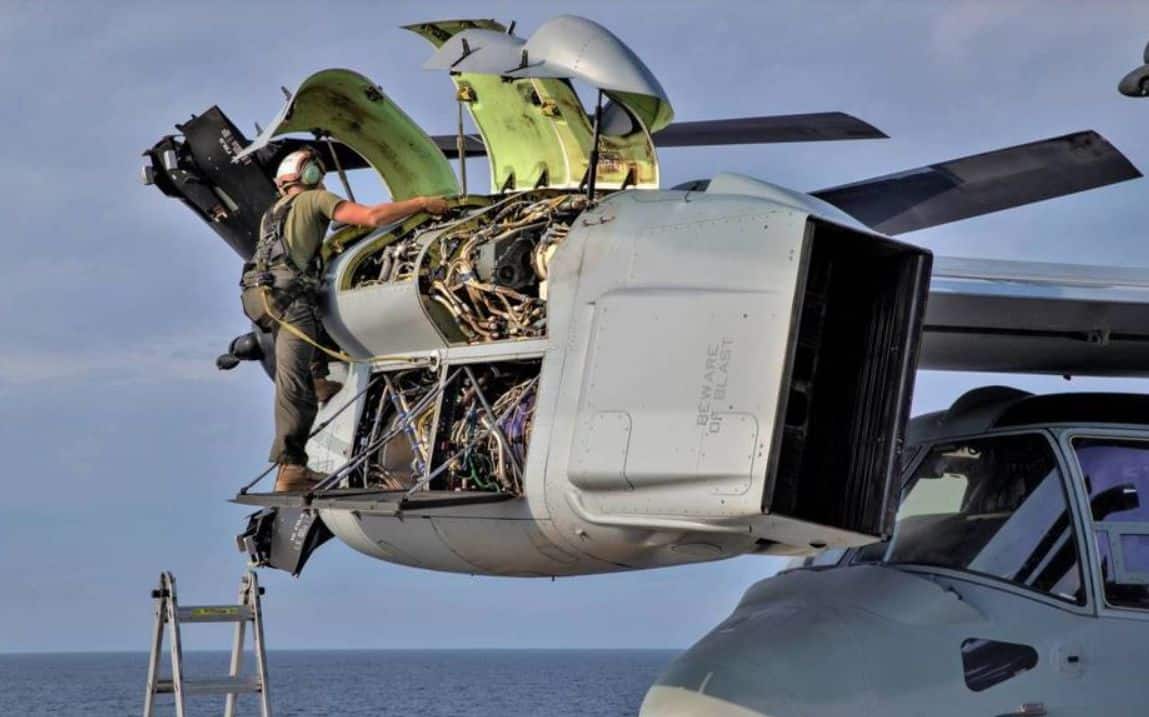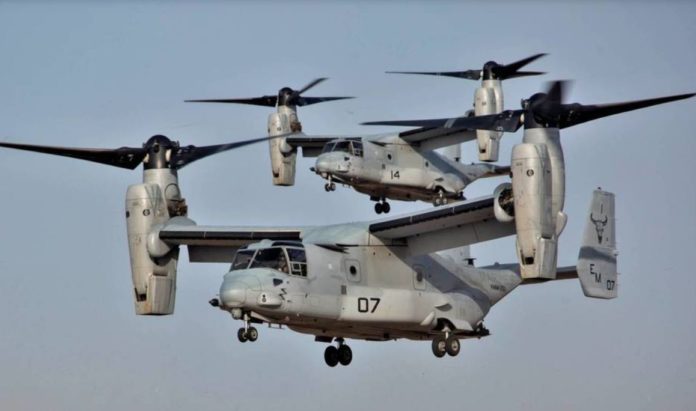The high maintenance and operating costs of this ‘convertiplano’ mean that only the US or Japan have decided to count on them. Something that may change soon
Israel has very high-level armed forces, it is no secret, but keeping this military power in a permanent state of availability and with material according to these requirements is not easy and requires continuous efforts in developments and acquisitions. Now that the need to replace part of their fleet of heavy transport helicopters is urgent, they look forward to a spectacular aircraft: the Bell Boeing V-22 Osprey. This is the incredible machine that never goes unnoticed.
Israel is going through a few moments of considerable uncertainty with three elections in a year and this has come to have consequences in something as fundamental to them as its army is, because it is motivating that many decisions to be taken are being delayed or postponed. One of them affects the replacement of two key elements for Israeli aviation, such as the replacement of its tankers and old heavy helicopters and the acquisition of a new model. For the first case, the plan is to replace the already obsolete B-707 cistern with KC-46A and the CH-53 Stallion with a model not yet defined. For the second, everything points to the V-22 Osprey.
Air importance
Both elements are crucial to the defense policy of that country since on the one hand, their fleet of tanks guarantees the ability to operate their planes and helicopters far from their borders and that of heavy helicopters to carry special operations equipment or troops to those same distant scenarios. That ‘distant scenario’ is none other than Iran.

In the case of helicopters the problem is even more serious with the CH-53 Stallion, a large helicopter without a doubt but in Israel, which operates about thirty copies, has had a long history of accidents, the most recent one in November. when one of them had an engine set on fire, it ended with the loss of the aircraft and, as a result, with its entire Stallion fleet on the ground.
Although for the replacement itself of the Stallion there would be several alternatives, from new CH-53K King Stallion or new CH-47 Chinook helicopters, the Israeli army wants the V-22 Osprey for obvious reasons, and that is the capabilities it would provide to the Groups Special Operations Israelis cannot be given any other model in the world.
The success of the ‘convertiplano’
The V-22 was born in the 80s and takes up the old idea of the ‘converti-plano‘, an aircraft that combines fixed-wing with tilting rotors and, therefore, would have the advantages of the helicopter and the aircraft. But it was not until the arrival of the Osprey that this phrase became a reality because previously all proposals for aircraft of this type were nothing more than failures, had poor performance and did not go beyond prototypes.
As an example of this we have the Bell XV-3, whose philosophy is actually the same as that of the Osprey, a fixed-wing and tilting rotors at the ends, very similar also to the proposals of tilt-wing aircraft, such as the LTV XC -142, where unlike the convertiplane, it was the entire lift plane that tilted with the engines themselves.
It is said that the idea that led to what is now V-22 came about as a result of the failure of the military operation that tried to free the American hostages at its embassy in Tehran. If you want to make an operation of this type, which involves the transfer of troops, in this case also recovery of civilian personnel and neither an airport nor one can be occupied, the only solution is the helicopter assault. The helicopter (8 RH-53D Sea Stallion was used in that mission) works, but if the distance to be covered is very large, the weak point of the helicopter emerges: it is slow and with little autonomy. This makes the mission lengthen, complicate and become much more difficult.
The V-22 came to solve this problem because, half helicopter and half-plane, finally combined in an effective way the advantages of the helicopter in terms of ability to land and take off vertically, with those of an aeroplane, which are the highest speed Flight and range. It was, therefore, a prodigious machine.
Difficult beginnings and many problems
The development of the V-22 was not exactly a path of roses and went through many difficulties that motivated even the question of the viability of the project that, in fact, was about to be canceled twice. For this project, put out to tender, and then independent companies Bell and Boeing Vertol (the Boeing helicopter branch), both with enormous experience in helicopters, allied and won the tender based on the Bell XV-15 prototype, a convertiplane Very promising experimental. 6 prototypes for tests were built and the first flight, in ‘helicopter mode’ only, was carried out on March 19, 1989, and in September of that same year, it was done in ‘aeroplane’ mode.
But many problems arose. The main one was the transition between helicopter mode and airplane mode. Both machines, helicopter and airplane may seem similar, but they are piloted very differently and the V-22 should be both. At one point, for example in vertical take-off, a helicopter is actually being piloted and already in the air, as horizontal speed is taken, a transition is made to the aeroplane mode and, from there, what you have It is a plane in normal flight. More difficult is the opposite operation, in which the aerodynamic speed must be reduced to a minimum (which, in an aeroplane, except Harrier, would be crazy) by piloting a helicopter and landing as such.
The first dilemma was to determine what type of pilot was needed, whether a helicopter or a plane. Both things were tested and it was seen that it was not a determining issue, because problems always appeared in the transition phase. They were serious problems that caused several accidents and the loss of two of the prototypes. In 2000, even with pre-production units and in the operational testing phase, two fatal accidents occurred where 23 Marines died and changes were introduced in various aspects related to flight controls. Nevertheless, the Osprey moved on.
However, accidents were not the main obstacle, but the excessive increases in development costs, causing the price of each Osprey to increase in alarming amounts reaching 60 and even 70 million dollars, twice that of a contemporary helicopter such as the Stallion, which has a similar load capacity.
Operational success
The explanation for its excessive costs must be sought on the one hand in its random and long development program, where many and very difficult engineering challenges had to be overcome and, on the other, in its undeniable capabilities, which make the Osprey an aircraft desired by any army To understand their constructive challenges, it is necessary to think about what they load with 9 tons, their engines are located at the ends of some wings on which they have to pivot and, all this, in addition, be folded for their naval operation.
To understand their capabilities we can establish an interesting comparison with an airplane and with a helicopter because in reality the Osprey is both. If we compare by load capacity, in the environment of 9 tons we have for example the C-295 aircraft and the CH-47 Chinook helicopter, although the latter can transport up to 12 tons. Both models are well known and in service.
The C-295 flies at a cruising speed of 480 km / h and has a load range of more than 2,000 km. Its two engines give a unit power of 2,680 hp and cost about 24 million dollars. The CH-47D flies at 220 km / h (and is a fast helicopter), its range is 700 km, its turbines give the power of 3,800 hp each and cost about 40 million dollars. Faced with these figures, the Osprey shines with its own light. It is capable of carrying its 9 tons of cargo at a cruising speed of 450 km / h (similar to the C-295), its range is almost 1,700 km and its two engines give 6,235 hp each. That is, it has the capabilities of a good medium transport aircraft with the versatility of shots and take-offs of a heavy helicopter, which it exceeds by more than double in scope. The Osprey, on the other hand, costs the sum of both.
It combines the capabilities of a medium transport plane with those of a heavy helicopter
Who wouldn’t want a machine like this in their inventory? Anyone who has no problem paying the bill that would come later and that is, as well as its high operating and maintenance costs per flight hour, the reason why only the United States and Japan are today its users. Israel, which is not one of those who are frightened by large numbers associated with their arms purchases, will end up acquiring this aircraft, as it will open a new world of possibilities to its command operations.
Touchdown
Flying in the Osprey is, as some would say, a religious experience. The Osprey can not only take off and land vertically, but it can also take off in a short race from dirt tracks. To do this they place their engines at an angle of 45 degrees and take off like a plane. The sensation is similar to what you have, for example, in a tactical take-off with a C-295: a sharp acceleration. But there it ends. After a short run, the machine lifts the flight and begins to climb like a demon. This feeling is new and its ascending speed is more than 2,300 feet/minute, while Chinook’s is “only” 1,500 feet/minute.
Already in the air, the transition to horizontal flight is not noticeable and from there it is like going on any plane. At the time of taking land, the deceleration becomes strange when diminishing the speed, but it is the same that feels in a helicopter and, from there until taking earth, three quarters of the same.
